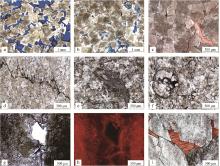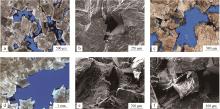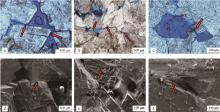

石油与天然气地质 ›› 2020, Vol. 41 ›› Issue (1): 116-131.doi: 10.11743/ogg20200111
杨天博1,2,3( ), 何治亮3,4,*(
), 何治亮3,4,*( ), 金振奎5, 张军涛2,3, 李双建2,3
), 金振奎5, 张军涛2,3, 李双建2,3
收稿日期:2019-07-29
出版日期:2020-02-01
发布日期:2020-01-19
通讯作者:
何治亮
E-mail:3006180012@cugb.edu.com;hezl.syky@sinopec.com
第一作者简介:杨天博(1993-),男,博士研究生,碳酸盐岩储层。E-mail:基金项目:
Tianbo Yang1,2,3( ), Zhiliang He3,4,*(
), Zhiliang He3,4,*( ), Zhenkui Jin5, Juntao Zhang2,3, Shuangjian Li2,3
), Zhenkui Jin5, Juntao Zhang2,3, Shuangjian Li2,3
Received:2019-07-29
Online:2020-02-01
Published:2020-01-19
Contact:
Zhiliang He
E-mail:3006180012@cugb.edu.com;hezl.syky@sinopec.com
Supported by:摘要:
四川盆地西北部龙门山山前中二叠统白云岩储层埋藏深度大,经历了漫长的埋藏期成岩演化,现今仍有丰富的储集空间保存,并发现了孔隙式白云岩气藏,但白云岩储层质量的非均质性较强,不同类型的白云岩储层中储集空间的形成和保持机理还有待更深入的研究。结合物性测试、压汞实验和CT扫描,白云岩储层中可识别出3种孔喉结构类型,其中Ⅰ类孔喉配位数高、连通性较好,大孔粗喉型的孔喉组合占主导,Ⅱ类包括了大孔中喉型和中孔中喉型两套孔喉组合,孔喉非均质性强,Ⅲ类受压溶作用影响较强主要发育小孔细喉型孔喉组合。白云岩储层孔喉结构的差异性主要取决于先驱灰岩的岩石组构和后期多种成岩作用的叠加耦合。Ⅰ,Ⅱ类储层一般由多孔颗粒灰岩经白云化形成,白云化作用进行得较彻底,主要发育在平直自形-半自形白云岩中,但Ⅰ类储层比Ⅱ类储层受中晚期溶蚀作用的改造更强且过度白云化作用影响较弱;而残余结构白云岩和非平直他形白云岩由于抗压溶能力更弱和后期过度白云化作用更强因而仅能形成Ⅲ类储层。
中图分类号:

图4
川西北中二叠统不同微观结构类型白云岩镜下照片 a.平直晶面自形中-粗晶白云岩,雾心亮边结构明显,孔隙中常见沥青充填,单偏光,蓝色铸体,栖二段,ST3井,埋深7 458.6 m;b.平直晶面半自形中-粗晶白云岩,雾心亮边结构明显,单偏光,蓝色铸体,栖二段,ST3井,埋深7 458.9 m;c.平直晶面半自形-非平直晶面他形中-细晶白云岩,单偏光,茜素红染色,栖二段,广元长江沟剖面;d.非平直晶面他形细晶白云岩,伴有缝合线发育,单偏光,蓝色铸体,栖二段,ST3井,埋深7 460.1 m;e.残余生屑白云岩,在云斑内仍可见灰质苔藓虫生屑,单偏光,栖二段,ST3井,埋深7 430.7 m;f.具有腹足类生屑幻影的白云岩,单偏光,栖二段,ST3井,埋深7 430.9 m;g.溶洞中充填的平直自形-半自形中-粗晶白云石胶结物,晶粒直径明显大于基质白云岩,单偏光,栖二段,ST3井,埋深7 449.1 m;h.图g的阴极发光图像,白云石胶结物具有明显的环带结构,且其发光性明显暗于周围的细晶白云岩基质;i.裂缝中充填的鞍状白云石胶结物,晶面弯曲呈镰刀状,单偏光,茜素红染色,栖二段,ST3井,埋深7 441.0m "


图5
川西北中二叠统白云岩储层孔隙类型 a.晶间孔,孔隙中见沥青充填,单偏光,蓝色铸体,栖二段,ST3井,埋深7 458.7 m;b.晶间孔,孔隙周缘的白云石常具有平直晶面,且自形程度较好,SEM照片,栖二段,ST3井,埋深7 458.1 m;c.基质溶孔,孔隙周围可见溶蚀痕迹,单偏光,蓝色铸体,栖二段,ST3井,埋深7 457.7 m;d.基质溶洞,孔隙周围可见溶蚀痕迹,单偏光,蓝色铸体,栖二段,ST3井,埋深7 449.2 m;e.基质溶孔,孔隙周缘的白云石被溶蚀残缺不全,SEM照片,栖二段,ST3井,埋深7 458.7 m;f.晶内溶孔,发育在白云石晶体内部,呈内凹的中空状,SEM照片,栖二段,ST3井,埋深7 458.1 m "


图6
川西北中二叠统白云岩储层喉道类型 a.规则-短喉型喉道(红色箭头所指),蓝色铸体,栖二段,ST3井,埋深7 448.92;b.构造裂缝型喉道(红色箭头所指),蓝色铸体,栖二段,ST3井,埋深7 449.10 m;c.孔隙缩小型喉道(红色箭头所指),白云石晶体堵塞溶孔形成,蓝色铸体,栖二段,ST3井, 7 457.90 m;d.规则-短喉型喉道(红色箭头所指),SEM照片,栖二段,ST3井,埋深7 458.10 m;e.弯曲-曲折型喉道(红色箭头所指),SEM照片,栖二段,ST3井,埋深7 458.90 m;f.孔隙缩小型喉道(红色箭头所指),由于白云石大晶体的过度生长形成,SEM照片,栖二段,ST3井,埋深7 456.80 m "

表1
川西北中二叠统白云岩储层孔隙结构类型划分"
| 孔隙结构类别 | Ⅰ类 | Ⅱ类 | Ⅲ类 | Ⅳ类 | |
| 孔隙结构总体特征 | 中孔低渗大孔粗喉型 | 中-低孔特低渗中孔中喉型 | 低孔特低渗小孔细喉型 | 特低孔特低渗微孔微喉型 | |
| 物性特征 | 孔隙度/% | > 6 | 4~6 | 2~4 | < 2 |
| 渗透率/(10-3μm2) | > 1.0 | 0.1~1.0 | < 0.1 | < 0.1 | |
| 压汞曲线 | 排驱压力/MPa | < 0.2 | 0.2~0.4 | 0.4~1.0 | > 1.0 |
| 最大连通孔喉半径/μm | > 3.68 | 1.84~3.68 | 0.74~1.84 | < 0.74 | |
| 饱和度中值压力/MPa | < 1.2 | 1.2~4.0 | 4.0~8.0 | > 8.0 | |
| 饱和度中值半径/μm | > 0.61 | 0.18~0.61 | 0.09~0.18 | < 0.09 | |
| 分选系数 | > 2.0 | 1.5~2.0 | < 1.5 | < 1.5 | |
| 最大进汞饱和度/% | > 75 | 65~75 | 50~65 | < 50 | |
| 渗透率分布峰位/μm | > 1.00 | 0.50~1.00 | 0.25~0.50 | < 0.25 | |
| CT扫描 | CT平均孔隙半径/μm | > 80 | 50~80 | < 50 | — |
| CT平均喉道半径/μm | 50~80 | 25~50 | < 25 | — | |
| 平均孔喉配位数 | > 5 | 3~5 | < 3 | — | |
| 岩石学特征 | 岩性产状 | 块状白云岩 | 块状白云岩 | 块状白云岩、斑状白云岩 | 灰岩 |
| 微观结构类型 | A1平直晶面自形晶白云岩、A2平直晶面半自形晶白云岩 | A1平直晶面自形晶白云岩、A2平直晶面半自形晶白云岩、A3过渡型白云岩 | A3过渡型白云岩、A4非平直晶面他形晶白云岩、B残余结构白云岩 | (含)泥质灰泥生屑灰岩、(含)生屑灰泥灰岩、(含)泥质灰泥灰岩 | |
| 主要孔隙类型 | 晶间溶孔、溶洞 | 晶间孔、晶间溶孔 | 晶间孔、晶间微孔 | 晶间微孔、粒间微孔 | |
| 主要喉道类型 | 规则-短喉型、孔隙缩小型 | 规则-短喉型、孔隙缩小型 | 弯曲-曲折型、孔隙缩小型 | — | |
| 储层分类评价 | Ⅰ类储层 | Ⅱ类储层 | Ⅲ类储层 | 非储层 |
| 1 | 马永生, 蔡勋育, 赵培荣, 等. 深层超深层碳酸盐岩优质储层发育机理和"三元控储"模式——以四川普光气田为例[J]. 地质学报, 2010, 84 (08): 1087- 1094. |
| Ma Yongsheng , Cai Xunyu , Zhao Peirong , et al. Formation mechanism of meep-buried carbonate reservoir and Its model of three-element controlling reservoir:A case study from the Puguang Oilfield in Sichuan[J]. Acta Geologica Sinica, 2010, 84 (08): 1087- 1094. | |
| 2 | 赵文智, 沈安江, 胡素云, 等. 中国碳酸盐岩储集层大型化发育的地质条件与分布特征[J]. 石油勘探与开发, 2012, 39 (1): 1- 12. |
| Zhao Wenzhi , Shen Anjiang , Hu Suyun , et al. Geological conditions and distributional features of large-scale carbonate reservoirs onshore China[J]. Petroleum Exploration and Development, 2012, 39 (1): 1- 14. | |
| 3 | 何治亮, 金晓辉, 沃玉进, 等. 中国海相超深层碳酸盐岩油气成藏特点及勘探领域[J]. 中国石油勘探, 2016, 21 (01): 3- 14. |
| He Zhiliang , Jin Xiaohui , Wo Yujin , et al. Hydrocarbon accumulation characteristics and exploration domains of ultra-deep marine carbonates in China[J]. China Petroleum Exploration, 2016, 21 (01): 3- 14. | |
| 4 | 何治亮, 张军涛, 丁茜, 等. 深层-超深层优质碳酸盐岩储层形成控制因素[J]. 石油与天然气地质, 2017, 38 (04): 633- 644. |
| He Zhiliang , Zhang Juntao , Ding Qian , et al. Factors controlling the formation of high-quality deep to ultra-deep carbonate reservoirs[J]. Oil & Gas Geology, 2017, 38 (4): 633- 644. | |
| 5 | Schmoker J W , Halley R B . Carbonate porosity versus depth:a predictable relation for south Florida[J]. AAPG Bulletin, 1982, 66 (12): 2561- 2570. |
| 6 | Sun S Q . Dolomite reservoirs:porosity evolution and reservoir characteristics[J]. AAPG Bulletin, 1995, 79 (2): 186- 204. |
| 7 |
Warren J . Dolomite:occurrence, evolution and economically important associations[J]. Earth-Science Reviews, 2000, 52 (1-3): 1- 81.
doi: 10.1016/S0012-8252(00)00022-2 |
| 8 | Moore C H , Wade W J . Carbonate reservoirs:Porosity and diagenesis in a sequence stratigraphic framework[M]. Newnes, 2013. |
| 9 | 陈代钊, 钱一雄. 深层-超深层白云岩储集层:机遇与挑战[J]. 古地理学报, 2017, 19 (2): 187- 196. |
| Chen Daizhao , Qian Yixiong . Deep or super-deep dolostone reservoirs:Opportunities and challenges[J]. Journal of Palaeogeography, 2017, 19 (2): 187- 196. | |
| 10 |
沈平, 张健, 宋家荣, 等. 四川盆地中二叠统天然气勘探新突破的意义及有利勘探方向[J]. 天然气工业, 2015, 35 (07): 1- 9.
doi: 10.3787/j.issn.1000-0976.2015.07.001 |
|
Shen Ping , Zhang Jian , Song Jiarong , et al. Significance of new breakthrough in and favorable targets of gas explorationin the Middle Permian system, Sichuan Basin[J]. Natural Gas Industry, 2015, 35 (07): 1- 9.
doi: 10.3787/j.issn.1000-0976.2015.07.001 |
|
| 11 |
杨光, 汪华, 沈浩, 等. 四川盆地中二叠统储层特征与勘探方向[J]. 天然气工业, 2015, 35 (7): 10- 16.
doi: 10.3787/j.issn.1000-0976.2015.07.002 |
|
Yang Guang , Wang Hua , Shen Hao , et al. Characteristics and exploration prospects of Middle Permian reservoirsin the Sichuan Basin[J]. Natural Gas Industry, 2015, 35 (7): 10- 16.
doi: 10.3787/j.issn.1000-0976.2015.07.002 |
|
| 12 |
石新, 王兴志, 张帆, 等. 川西北地区栖霞组白云岩储集层研究[J]. 西南石油学院学报, 2005, 27 (2): 13- 16.
doi: 10.3863/j.issn.1674-5086.2005.02.004 |
|
Shi Xin , Wang Xingzhi , Zhang Fan , et al. The study of dolomite reservoirs in Qixia Formation in the northwest of Sichuan Region[J]. Journal of Southwestern Petroleum Institute, 2005, 27 (2): 13- 16.
doi: 10.3863/j.issn.1674-5086.2005.02.004 |
|
| 13 |
郝毅, 周进高, 张建勇, 等. 川西北中二叠统栖霞组白云岩储层特征及控制因素[J]. 沉积与特提斯地质, 2013, 33 (1): 68- 74.
doi: 10.3969/j.issn.1009-3850.2013.01.011 |
|
Hao Yi , Zhou Jingao , Zhang Jianyong , et al. The dolostone reservoirs from the Middle Permian Qixia Formation in northwestern Sichuan Basin:Characteristics and controlling factors[J]. Sedimentary Geology and Tethyan Geology, 2013, 33 (1): 68- 74.
doi: 10.3969/j.issn.1009-3850.2013.01.011 |
|
| 14 |
何登发, 李德生, 张国伟, 等. 四川多旋回叠合盆地的形成与演化[J]. 地质科学, 2011, (3): 589- 606.
doi: 10.3969/j.issn.0563-5020.2011.03.001 |
|
He Dengfa , Li Desheng , Zhang Guowei , et al. Formation and evolution of multi-cycle superposed Sichuan Basin, China[J]. Scientia Geologica Sinica, 2011, (3): 589- 606.
doi: 10.3969/j.issn.0563-5020.2011.03.001 |
|
| 15 |
贾东, 陈竹新, 贾承造, 等. 龙门山前陆褶皱冲断带构造解析与川西前陆盆地的发育[J]. 高校地质学报, 2003, (03): 402- 410.
doi: 10.3969/j.issn.1006-7493.2003.03.010 |
|
Jia Dong , Chen Zhuxin , Jia Chengzao , et al. Structrual features of the Longmen Shan Fold and thrust belt and development of the Western Sichuan Foreland Basin, Central China[J]. Geological Journal of China Universities, 2003, (03): 402- 410.
doi: 10.3969/j.issn.1006-7493.2003.03.010 |
|
| 16 | 郭正吾, 邓康龄, 韩永辉, 等. 四川盆地形成与演化[M]. 北京: 地质出版社, 1996. |
| Guo Zhengwu , Deng Kangling , Han Yonghui , et al. Formation and evolution of Sichuan Basin[M]. Beijing: Geological Press, 1996. | |
| 17 |
陈竹新, 贾东, 魏国齐, 等. 龙门山北段冲断前锋构造带特征[J]. 石油学报, 2008, (05): 657- 662.
doi: 10.3321/j.issn:0253-2697.2008.05.005 |
|
Chen Zhuxin , Jia Dong , Wei Guoqi , et al. Characteristics of thrust structures in the northern Longmenshan front belt[J]. Acta Petrolei Sinica, 2008, (05): 657- 662.
doi: 10.3321/j.issn:0253-2697.2008.05.005 |
|
| 18 | 邓莉, 刘君龙, 钱玉贵, 等. 川西地区龙门山前带侏罗系物源与沉积体系演化[J]. 石油与天然气地质, 2019, 40 (2): 380- 391. |
| Deng Li , Liu Junlong , Qian Yugui , et al. Provenance and sedimentary system of the Jurassic successions in the front of Longmen Mountain in western Sichuan Basin[J]. Oil & Gas Geology, 2019, 40 (2): 380- 391. | |
| 19 | 李大军, 陈辉, 陈洪德, 等. 四川盆地中二叠统茅口组储层形成与古构造演化关系[J]. 石油与天然气地质, 2016, 37 (05): 756- 763. |
| Li Dajun , Chen Hui , Chen Hongde , et al. Relationship between reservoir development in the Middle Permian Maokou Formation and paleostructure evolution in the Sichuan Basin[J]. Oil & Gas Geology, 2016, 37 (05): 756- 763. | |
| 20 | 魏国齐, 杨威, 朱永刚, 等. 川西地区中二叠统栖霞组沉积体系[J]. 石油与天然气地质, 2010, 31 (04): 442- 448. |
| Wei Guoqi , Yang Wei , Zhu Yonggang , et al. Depositional system of the Middle Permian Qixia Formation in the western Sichuan Basin[J]. Oil & Gas Geology, 2010, 31 (04): 442- 448. | |
| 21 | 黎荣, 胡明毅, 杨威, 等. 四川盆地中二叠统沉积相模式及有利储集体分布[J]. 石油与天然气地质, 2019, 40 (2): 369- 379. |
| Li Rong , Hu Mingyi , Yang Wei , et al. Sedimentary facies model and favorable reservoir distribution of the Middle Permian in Sichuan Basin[J]. Oil & Gas Geology, 2019, 40 (2): 369- 379. | |
| 22 |
郑超, 王宇峰, 汤兴宇, 等. 双鱼石地区栖霞组层序地层划分及沉积相分析[J]. 特种油气藏, 2018, 25 (4): 39- 45.
doi: 10.3969/j.issn.1006-6535.2018.04.008 |
|
Zheng Chao , Wang Yufeng , Tang Xingyu , et al. Sequence stratigraphic division and sedimentary facies analysis of Qixia Formation in the Shuangyushi Block[J]. Special Oil & Gas Reservoirs, 2018, 25 (4): 39- 45.
doi: 10.3969/j.issn.1006-6535.2018.04.008 |
|
| 23 | 于海跃, 尹伟, 刘君龙. 龙门山山前带侏罗系近源冲积体系沉积特征与成因模式[J]. 断块油气田, 2019, 26 (03): 273- 278. |
| Yu Haiyue , Yin Wei , Liu Junlong . Sedimentary characteristics and genetic model of Jurassic alluvial deposits in piedmont zone of Longmen Mountain[J]. Fault-Block Oil and Gas Field, 2019, 26 (03): 273- 278. | |
| 24 |
Machel H G . Concepts and models of dolomitization:a critical reappraisal[J]. Geological Society, 2004, 235 (1): 7- 63.
doi: 10.1144/GSL.SP.2004.235.01.02 |
| 25 | 王丹, 陈代钊, 杨长春, 等. 埋藏环境白云石结构类型[J]. 沉积学报, 2010, 28 (01): 17- 25. |
| Wang Dan , Chen Daizhao , Yang Changchun , et al. Classification of texture in burial dolomite[J]. Acta Sedimentologica Sinica, 2010, 28 (01): 17- 25. | |
| 26 | Gregg J M , Sibley D F . Epigenetic dolomitization and the origin of xenotopic dolomite texture[J]. Journal of Sedimentary Research, 1984, 54 (3): 908- 931. |
| 27 | Sibley D F , Gregg J M . Classification of dolomite rock textures[J]. Journal of Sedimentary Research, 1987, 57 (6): 967- 975. |
| 28 |
Davies G R , Smith Jr L B . Structurally controlled hydrothermal dolomite reservoir facies:An overview[J]. AAPG Bulletin, 2006, 90 (11): 1641- 1690.
doi: 10.1306/05220605164 |
| 29 | Machel H G . Saddle dolomite as a by-product of chemical compaction and thermochemical sulfate reduction[J]. Geology, 1987, 15 (10): 1301- 1306. |
| 30 | 纪友亮. 油气储层地质学[M]. 北京: 中国石油大学出版社, 2009. |
| Ji Youliang . Oiland gas reservoir geology[M]. Beijing: China University of Petroleum Press, 2009. | |
| 31 | 罗蛰潭. 油气储集层的孔隙结构[M]. 北京: 科学出版社, 1986. |
| Luo Zhetan . Pore structure of oil and gas reservoirs[M]. Beijing: Science Press, 1986. | |
| 32 | 吴元燕, 徐龙, 张昌明. 油气储层地质[M]. 北京: 石油工业出版社, 1996. |
| Wu Yuanyan , Xu Long , Zhang Changming . Oil and gas reservoir geology[M]. Beijing: Petroleum Industry Press, 1996. | |
| 33 |
胡安平, 潘立银, 郝毅, 等. 四川盆地二叠系栖霞组、茅口组白云岩储层特征、成因和分布[J]. 海相油气地质, 2018, 23 (02): 39- 52.
doi: 10.3969/j.issn.1672-9854.2018.02.006 |
|
Hu Anping , Pan Liyin , Hao Yi , et al. Origin, characteristics and distribution of dolostone reservoir in Qixia Formation and Maokou Formation, Sichuan Basin, China[J]. Marine Origin Petroleum Geology, 2018, 23 (02): 39- 52.
doi: 10.3969/j.issn.1672-9854.2018.02.006 |
|
| 34 | 朱传庆, 徐明, 袁玉松, 等. 峨眉山玄武岩喷发在四川盆地的地热学响应[J]. 科学通报, 2010, 55 (6): 474- 482. |
| Zhu Chuanqing , Xu Ming , Yuan Yusong , et al. Palaeo-geothermal response and record of the effusing of Emeishan basalts in Sichuan Basin[J]. Chinese Science Bulletin, 2010, 55 (6): 474- 482. | |
| 35 |
Zhu C , Hu S , Qiu N , et al. Geothermal constraints on Emeishan mantle plume magmatism:paleotemperature reconstruction of the Sichuan Basin, SW China[J]. International Journal of Earth Sciences, 2018, 107 (1): 71- 88.
doi: 10.1007/s00531-016-1404-2 |
| 36 |
黄思静, 潘小强, 吕杰, 等. 川西栖霞组的热液白云化作用及其后的倒退溶解——不彻底的回头白云化作用[J]. 成都理工大学学报(自然科学版), 2013, 40 (3): 288- 300.
doi: 10.3969/j.issn.1671-9727.2013.03.09 |
|
Huang Sijing , Pan Xiaoqiang , Lyu Jie , et al. Hydrothermal dolomitization and subsequent retrograde dissolution in Qixia Formation, West Sichuan:A case study of incomplete and halfway-back dolomitization[J]. Journal of Chengdu University of Technology.Science & Technology Edition, 2013, 40 (3): 288- 300.
doi: 10.3969/j.issn.1671-9727.2013.03.09 |
|
| 37 |
孟森, 周进高, 杨柳, 等. 川西地区中二叠统栖霞组中-粗晶白云岩成因[J]. 海相油气地质, 2017, 22 (01): 75- 83.
doi: 10.3969/j.issn.1672-9854.2017.01.010 |
|
Meng Sen , Zhou Jingao , Yang Liu , et al. Genesis of medium-coarse crystalline dolomite of Middle Permian Qixia Formation, Western Sichuan[J]. Marine Origin Petroleum Geology, 2017, 22 (01): 75- 83.
doi: 10.3969/j.issn.1672-9854.2017.01.010 |
|
| 38 | 黄思静. 碳酸盐岩的成岩作用[M]. 北京: 地质出版社, 2010. |
| Huang Sijing . Carbonate diagenesis[M]. Beijing: Geological Press, 2010. | |
| 39 |
Machel H , Mountjoy E W . Chemistry and environments of dolomitization-A reappraisal[J]. Earth-Science Reviews, 1986, 23 (3): 175- 222.
doi: 10.1016/0012-8252(86)90017-6 |
| 40 | Murray R C . Origin of porosity in carbonate rocks[J]. Journal of Sedimentary Research, 1960, 30 (1): 59- 84. |
| 41 | Wardlaw N C . Pore geometry of carbonate rocks as revealed by pore casts and capillary pressure[J]. AAPG Bulletin, 1976, 60 (2): 245- 257. |
| 42 |
Wierzbicki R , Dravis J J , Al-Aasm I , et al. Burial dolomitization and dissolution of Upper Jurassic Abenaki platform carbonates, Deep Panuke reservoir, Nova Scotia, Canada[J]. AAPG Bulletin, 2006, 90 (11): 1843- 1861.
doi: 10.1306/03200605074 |
| 43 | 丁茜, 何治亮, 沃玉进, 等. 高温高压条件下碳酸盐岩溶蚀过程控制因素[J]. 石油与天然气地质, 2017, 38 (04): 784- 791. |
| Ding Qian , He Zhiliang , Wo Yujin , et al. Factors controlling carbonate rock dissolution under high temperature and pressure[J]. Oil & Gas Geology, 2017, 38 (04): 784- 791. |
| [1] | 方锐, 蒋裕强, 杨长城, 邓海波, 蒋婵, 洪海涛, 唐松, 谷一凡, 朱讯, 孙莎莎, 蔡光银. 四川盆地侏罗系凉高山组不同岩性组合页岩油赋存状态及可动性[J]. 石油与天然气地质, 2024, 45(3): 752-769. |
| [2] | 何骁, 郑马嘉, 刘勇, 赵群, 石学文, 姜振学, 吴伟, 伍亚, 宁诗坦, 唐相路, 刘达东. 四川盆地“槽-隆”控制下的寒武系筇竹寺组页岩储层特征及其差异性成因[J]. 石油与天然气地质, 2024, 45(2): 420-439. |
| [3] | 翟常博, 林良彪, 尤东华, 刘冯斌, 刘思雨. 川西南地区中二叠统茅口组一段沉积微相特征及有机质富集模式[J]. 石油与天然气地质, 2024, 45(2): 440-456. |
| [4] | 张赫驿, 杨帅, 张玺华, 彭瀚霖, 李乾, 陈聪, 高兆龙, 陈安清. 川东地区中二叠统茅口组沉积微相与环境演变[J]. 石油与天然气地质, 2024, 45(2): 457-470. |
| [5] | 潘辉, 蒋裕强, 朱讯, 邓海波, 宋林珂, 王占磊, 李杪, 周亚东, 冯林杰, 袁永亮, 王猛. 河流相致密砂岩气地质甜点评价[J]. 石油与天然气地质, 2024, 45(2): 471-485. |
| [6] | 张宝收, 张本健, 汪华, 陈践发, 刘凯旋, 豆霜, 戴鑫, 陈双玲. 四川盆地金秋气田:一个典型以中生界沉积岩为氦源岩的含氦-富氦气田[J]. 石油与天然气地质, 2024, 45(1): 185-199. |
| [7] | 张自力, 乔艳萍, 豆霜, 李堃宇, 钟原, 武鲁亚, 张宝收, 戴鑫, 金鑫, 王斌, 宋金民. 四川盆地蓬莱气区震旦系灯影组二段岩溶古地貌与控储模式[J]. 石油与天然气地质, 2024, 45(1): 200-214. |
| [8] | 王光付, 李凤霞, 王海波, 周彤, 张亚雄, 王濡岳, 李宁, 陈昱辛, 熊晓菲. 四川盆地不同类型页岩气压裂难点和对策[J]. 石油与天然气地质, 2023, 44(6): 1378-1392. |
| [9] | 胡宗全, 王濡岳, 路菁, 冯动军, 刘粤蛟, 申宝剑, 刘忠宝, 王冠平, 何建华. 陆相页岩及其夹层储集特征对比与差异演化模式[J]. 石油与天然气地质, 2023, 44(6): 1393-1404. |
| [10] | 王红岩, 周尚文, 赵群, 施振生, 刘德勋, 焦鹏飞. 川南地区深层页岩气富集特征、勘探开发进展及展望[J]. 石油与天然气地质, 2023, 44(6): 1430-1441. |
| [11] | 边瑞康, 孙川翔, 聂海宽, 刘珠江, 杜伟, 李沛, 王濡岳. 四川盆地东南部五峰组-龙马溪组深层页岩气藏类型、特征及勘探方向[J]. 石油与天然气地质, 2023, 44(6): 1515-1529. |
| [12] | 李双建, 李智, 张磊, 李英强, 孟宪武, 王海军. 四川盆地川西坳陷三叠系盐下超深层油气成藏条件与勘探方向[J]. 石油与天然气地质, 2023, 44(6): 1555-1567. |
| [13] | 曾溅辉, 张亚雄, 张在振, 乔俊程, 王茂云, 陈冬霞, 姚泾利, 丁景辰, 熊亮, 刘亚洲, 赵伟波, 任克博. 致密砂岩气藏复杂气-水关系形成和分布主控因素及分布模式[J]. 石油与天然气地质, 2023, 44(5): 1067-1083. |
| [14] | 李军亮, 王鑫, 王伟庆, 李博, 曾溅辉, 贾昆昆, 乔俊程, 王康亭. 致密砂岩砂-泥结构发育特征及其对储集空间的控制作用[J]. 石油与天然气地质, 2023, 44(5): 1173-1187. |
| [15] | 王宏博, 马存飞, 曹铮, 李志鹏, 韩长城, 纪文明, 杨艺. 基于岩相的致密砂岩差异成岩作用及其储层物性响应[J]. 石油与天然气地质, 2023, 44(4): 976-992. |
| 阅读次数 | ||||||
|
全文 |
|
|||||
|
摘要 |
|
|||||